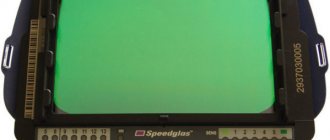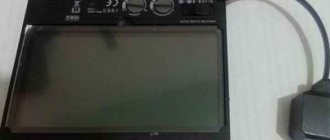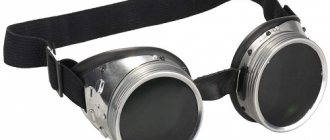Home / Accessories and parts
Back
Reading time: 3 min
0
7258
Welding work is a high-risk task, so a person must provide himself with reliable protection so as not to get hurt during work.
Very often a person suffers from sparks when working with metal, different types of radiation, gases and vapors are released during the welding process, different types of radiation...
The Chameleon welding mask is your first assistant in protecting against unpleasant consequences during work.
- Features when working with a chameleon welding helmet
- How to fix it yourself
- How to use a welding mask
- How to serve
- Conclusion
What is a chameleon welding helmet?
The product appeared about 20 years ago. Initially, due to the use of special filters, its cost was very high. Modern technologies are moving forward, and now the chameleon welder mask is common. In appearance it looks like a regular one, but at the same time it has several characteristic differences. The advantages include:
- increased work efficiency;
- freedom of both hands while working;
- no need to replace filters;
- automatic dimming.
When choosing a chameleon welding helmet, it is important to take into account some of its features:
- there are temperature restrictions;
- It is important to store it switched off in a closet or case;
- there is forced ventilation;
- It takes time to activate the filter.
Chameleon welding helmet device
The design is simple, so the chameleon welding helmet includes:
- The housing provides protection from drops of metal or slag. Its shape helps the released gases escape quickly.
- The head mount is adjustable with three screws.
- Light filter module with compartment for batteries or solar panel. There are also sensors that activate the filter.
- The inner and outer chameleon glass for the welding helmet is made of hardboard.
How does a chameleon welding helmet work?
The device is triggered when a strong flash enters the field of view of the “glass”. The result is an instant darkening of the space; as soon as the spark disappears, the glass brightens, creating good visibility without lifting the mask. Glass with automatic light filters in a chameleon mask is the most suitable option for welding in difficult conditions.
Repair of a welder's mask Chameleon
| We are not talking about complex repairs, but just about replacing the batteries in the “Chameleon” welding helmet. It is a faulty power supply that causes failure in most cases. |
The main element of protection in the chameleon mask is an automatic light filter. It changes automatically as soon as the arc appears, allowing you to control the start of welding without blinding your eyes. As a rule, a light filter has a multilayer structure. The use of several liquid crystal layers makes it possible to reduce the dependence of dimming on the angle of incidence of light. When the arc is ignited, the crystals are arranged in a certain order, due to which part of the light flux is blocked.
For proper operation of the filter, a power source is required. For some models, these are two AAA batteries located in a special compartment on the filter housing. For other models, the power source is hidden inside the case. As a rule, these are one or two lithium elements with a voltage of 3 volts, which have a very long resource. Although it is logical to assume that a cheap mask has a cheap battery installed.
I use a Resanta welding helmet, although the model doesn't really matter. Light filters of all models have the same operating principle and differ only in the design, the element base used and the presence or absence of adjustments. Like many, I do not use welding every day, but only when necessary. And once again, getting ready to weld something there, I was disappointed to discover that the Chameleon welding helmet did not work.
When pointing at a light source, the filter did not darken or only worked once in a while. Be it the sun, a bright lamp or a lighter.
Sometimes, when I lightly tapped the mask, the light filter would work. This suggested that there was a bad contact somewhere, a loose connection or something similar. But first of all, I thought that the problem was in the power supply of the light filter. My battery is almost done.
In such cases, it is sometimes advised to expose the mask to the sun for about two hours so that the battery is recharged from the built-in LED panel.
Perhaps this is true. But I didn’t want to wait two hours every time. Moreover, it is unknown what the final result will be. Maybe it will work, maybe not. In short, I decided to figure out what exactly was going on there and, if possible, restore the filter’s functionality.
The light filter is attached to the mask using two screws. After unscrewing the screws, remove it. There is a narrow gap along the perimeter of the case. Carefully pushing the halves of the body apart, we divide it into two parts. It doesn't matter which way you do it.
Inside the case there is an electronic filling of the light filter and a lithium power source. The first thing you need to do is measure the voltage on it. The nominal voltage is 3 volts, but the light filter works properly when the voltage drops to 2.5 volts. However, this is just an assumption; there may be a spread in one direction or another. In my case, the voltage at the battery terminals was just over two volts, but nothing worked.
Having made sure that the battery is “dead”, we proceed to replacement. My filter used a CR2450 element. It is sealed into the board on both sides. We very carefully unsolder it and replace it with exactly the same new one.
If you don’t find the CR2450, you can replace it with the CR2032 element for a while; it is installed on computer motherboards. It is best to use the battery with a holder, this makes it easier to replace and you don’t have to overheat the “tablet” when soldering. As a last resort, you can solder two pins. Very quickly and with good flux, to perform the operation with one easy movement of the hand.
How to test a Chameleon mask without welding
When you hold down the Test button for five seconds, the filter should darken. If there is no such configuration function, you need to check Chameleon in other ways. The sensors are triggered by a powerful light beam. The filter is turned towards the light source at least three times, the screen should darken in all cases. Light protection reacts to:
- radiation from the sun (the filter should darken and open after an exposure interval, because the flow is of constant intensity);
- red spirals of incandescent lamps (darkening persists throughout the entire period of being near the emitter; it operates at an alternating current frequency);
- a spark from a silicon lighter (the filter darkens sporadically when the wheel knocks out a spark);
- remote control for household appliances (sensors react to infrared radiation pulses, the light output of the remote control is uniform);
- smartphone screen during flash.
If the filter does not respond, check the power supply: change the batteries or batteries, charge the solar panels. The sensitivity of the filter is checked with an incandescent lamp. If the spiral is equally visible at different settings, the regulator does not work.
How to properly set up a chameleon mask for welding? What do you need to remember when working?
In order to know how to set up the mask and how to check its performance, it is better to refer to the operating instructions. Important to remember:
- the chameleon mask is not suitable for plasma and gas welding and cutting;
- Do not leave the shield on a hot surface;
- It is better not to disassemble the filter cartridge;
- the shield will not withstand strong impacts;
- Changes cannot be made to the filter. It is allowed to use spare parts specified in the instructions;
- if the chameleon welding helmet does not darken the image, you need to stop working and identify the possible cause of the malfunction;
- it is necessary to prevent moisture from entering the light filter;
- When cleaning the shield, it is not recommended to use detergents and solvents;
- the headband for putting on can cause an allergic reaction, the straps must be adjusted correctly to prevent skin irritation;
- In order to change the batteries, switch the shield to grinding mode. When the red light on the filter lights up, you need to replace the batteries;
- Before starting work, you need to adjust the mask to suit yourself to achieve maximum comfort. You can select the darkness level, delay time and sensitivity level.
What should a welder pay attention to when selecting a Chameleon mask?
For welding helmet filters, there are four main parameters that are indicated on the product by the manufacturer and are standardized throughout the world:
- optical class;
- light scattering;
- homogeneity;
- angular dependence of the degree of darkening.
According to the European standard EN 379, they must be applied to the filter, indicating the class of each parameter through a slash and a mandatory link to the standard. For example, 1/1/1/2 EN 379.
How to fix it yourself
The main question is what is the problem with dimming. Let's see what goes wrong most often. A common defect is that a chameleon mask does not darken light radiation, and this is its main task.
One of the root causes may be batteries that have zero charge.
The mask has two batteries: standard AA batteries and solar energy, which is powered through a panel in the body. Usually just replacing the battery is enough.
But if replacing the batteries does not help, then you can try charging from solar energy, leaving the mask for a short period in the sun or bright light.
But this is not the main reason and the way to solve it. This is not one of the possible sources of the dimming problem. There may also be a problem with the protective glass. Usually this damage is visible to the naked eye: chips, cracks, abrasions.
The solution to this problem is usually to replace the mesomorphic glass, which is one of the most expensive elements of the mask. But only glass that is completely similar to the previous one will do, watch this carefully.
“If the light filter blinks, check whether the protective glass is dirty. In the worst case, it may be damaged. If it is damaged, the light filter with protective glass must be replaced.”
With such a problem, it is better to contact a specialist rather than deal with it yourself. The service center is here to help you. Of course, this is not the most economical option, but this way you will know that the root cause of the defect has been accurately identified and they know how to eliminate it.
When working with a welding machine, many factors affect vision impairment, which the Chamaleon mask helps prevent, therefore, when using the mask, make sure that the headband is properly secured, make sure there is good lighting, check that there is no protective film on the glass, and monitor the level of darkness.
High and low temperatures often affect the degree of darkening and may be the reason for its delay. The manufacturer warns that at -10C the Chameleon mask may not work correctly.
Existing faults. Do-it-yourself chameleon welding helmet repair
Let's look at the question of why the shield may not work. Let's look at typical welding helmet malfunctions. It often happens that a chameleon welding mask does not perform its main function, namely, it does not reduce the level of light radiation. The essence of the problem may lie in dead batteries. The chameleon welding helmet can be powered by both regular AAA batteries and a solar panel located on the body. Simply put, replacing the battery can solve the problem. If we consider the first method of powering the shield with energy, then simply insert the batteries into it. If powered by a battery, you need to hold the shield under a bright light to charge it.
But even after this procedure, you may find that the shield still does not work. The reason may be the protective glass. Typically, with this type of malfunction, cracks, chips and other mechanical damage are visible on the glass. In this case, it is necessary to replace the liquid crystal glass, which is the most expensive component in the mask. It is important to remember that the new glass must fully comply with the previous one in all respects.
The filter may blink. Here the protective glass may be either simply dirty or damaged. In this case, it is better to immediately change the filter with protective glass.
It is better not to repair the light filter of a welding helmet yourself. It would be better to contact specialists at a service center. This will cost money, but the service center can accurately identify the cause of the breakdown and specialists will easily fix it.
Poor visibility does not have a beneficial effect on vision, so it is important to properly secure the headband, install a good lighting source in the workplace, remove the film from the protective glass, and adjust the degree of darkness. At low temperatures, there may be a delay in dimming. Do not use the mask at temperatures below - 10 degrees Celsius.
Replacing batteries in the Chameleon mask
Unfortunately, the CR2032 battery did not last long.
Despite the fact that current consumption is measured in microamps, after some time the filter did not work again. Of course, a question like “What should I do?” didn't even arise. It was necessary to install a more powerful power source. The most suitable option is two 1.5V elements of size AA or AAA. They can be placed in a special battery compartment, which is commercially available. I didn’t have one, so I had to saw off the battery compartment from my favorite TV remote control.
I sawed off the part where the contacts for the batteries are located from the printed circuit board. I cleaned everything unnecessary (microcircuit and wiring) and soldered two stranded wires to the contacts. The end was lightly covered with what was at hand. It turned out to be a good battery compartment for two AA elements.
The battery compartment is attached to the mask with two M2.5 bolts. The holes are drilled in the center, so the mount does not interfere with the installation of batteries in the compartment. Can be mounted anywhere. The wires should be as short as possible. I secured the compartment at the top, above my head. In this case, the overall balancing is not disturbed, and there is free access to the compartment for replacing batteries. During idle periods, you can even remove one battery from the compartment. For the purpose of, so to speak, global economy.
How to use a welding mask
Be sure to read the user manual before use, which can make it easier for you to adjust the mask for welding tasks and avoid any obscuring problems.
But remember:
- the Chameleon mask should fit tightly to your head and not create voids - this will give you confidence when working that the mask will not fall off and you will not be injured;
- To replace the power supply elements, it is necessary to transfer the shield to grinding. If the red light comes on, you need to change the batteries;
- if you are prone to allergies, then make sure that the belt for putting on does not rub the areas of contact, otherwise it is more likely that you may experience skin irritation;
- Do not use detergents or aggressive cleaning agents to clean the damper;
- the light filter does not handle moisture and may fail;
- if you notice that the quality of the darkening has deteriorated or is absent, then stop welding until the cause of the malfunction is determined;
- It is better not to change the specified settings for the light filter. Only the spare parts specified in the instructions are suitable for its adjustment;
- do not use physical force on the shield;
- It’s logical to take the filter cartridge to a specialist to find out what’s broken in it;
- a surface with elevated temperatures can damage the shield and cause dimming problems;
- The Chameleon mask is not used for plasma or gas welding.
Principle of operation
Automatic darkening of the “chameleon” mask is ensured by the presence of light filters made on the basis of liquid crystals. The property of liquid crystals to orient themselves in space under the influence of electrical voltage determines the operating principle of the mask.
In the normal state, when there is no serious light exposure on the screen, the crystals are in a position that allows daylight to pass freely through the screen. When the welding arc is ignited, a sensor is triggered , transmitting a signal to the electronic unit . After processing the signal by the electronic device, a command is given to rearrange the position of the crystals . They change their structure, which makes the screen dark (light radiation is blocked by the screen).
The duration of the crystal restructuring process takes a period of time no more than ten thousandths of a second . Almost instantaneous darkening makes it possible to keep the mask on throughout the entire length of the intermittent weld. After completing the welding work, it is possible to set a delay on the mask for the end of the screen darkening . This provides eye protection from the bright light of a weld that has not yet cooled down.
In high-quality and therefore expensive “chameleon” masks, the light filter has a multi-layer structure . The more layers, the more evenly the shading is distributed across the surface of the screen. The filter includes a separate layer that protects against ultraviolet and infrared radiation.
Classification of chameleon welding helmets
During production, markings must be applied to the product. The classification is based on the main function of the device - dimming adjustment. A welding helmet with an automatic light filter is marked with four numbers from 1 to 3, separated by a fraction. The lower the indicator, the higher the quality level. The meaning of each digit:
- Optics class. This indicator determines how well you can see through the glass. It is influenced by the type of glass, film and filter chosen for production.
- The degree of light scattering. The value indicates how clear the image will be. It all depends on the purity of the crystals.
- Shading uniformity. A parameter indicating the difference between the dark zone and the light zone.
- Angular dependence. Helps determine the relationship between a light filter and flash impact angle in the visible region.
Main characteristics of chameleon filters
Optical class is the most important characteristic and determines how clearly and without geometric distortion an object is visible through an automatic light filter. This is an indicator of the diopter of the filter. It directly depends on both the quality of the glass used in manufacturing and the assembly quality of the optical “sandwich”.
The optical class designation may consist of three or four digits. The meaning of the numbers included in the designation of chameleon filters: for example, 1/1/1/2.
The first number—the optical class—determines how clearly and without geometric distortion an object is visible through an automatic light filter. The light filter has a multilayer structure. A large number of refractive surfaces blur the image if the glass has even the slightest curvature. The plates must be of ideal quality. The first class is characterized by the absence of distortion of geometric shapes and clear focusing. The second and third classes cause rapid fatigue and eye fatigue, similar to incorrectly selected glasses. Such filters are unsuitable even for short-term work.
The second number is the degree of light dispersion. The higher quality the crystals, the less dispersion and higher quality.
The third number is the uniformity of the darkening of the filter. The filter contains several cavities with liquid crystals. The crystals are poured between the glasses, the distance between which is very small. Even with minimal glass non-flatness, this leads to spotty darkening.
The fourth number is the angular dependence. The smaller the angular dependence, the less distortion. To reduce the angular dependence, the amount of liquid crystals is increased, and this reduces other characteristics of the filters. Therefore, the number 2 is a normal indicator for most filters
Degree of initial darkening The lighter the initial state, the better it is visible. The degree of protection against harmful radiation must be at least 13DIN in any condition, regardless of whether the filter has worked or not.
Degree of darkening during weldingThe degree of darkening must correspond to the welding mode, i.e. the brightness of the welding arc, as well as the individual factors of the welder himself. Chameleon masks are made with darkening adjustments (9 – 13 DIN; 5 – 13 DIN).
Smooth manual adjustment of dimming, filter sensitivity and brightening delay
Professional filters come with three manual smooth adjustments:
- dimming (usually from 9 to 13 DIN, which corresponds to GOST filters C3-C9);
- sensitivity (can be set to protect against bright light radiation from a heated metal or electrode);
- opening delay time after welding is completed (so that the metal cools down and the afterglow does not “hit” the eyes, and also to prevent the filter from opening during short pauses).
Filter response time in temperature range
Almost all modern chameleon filters provide a response time of less than 0.001 seconds, which is enough to guarantee eye protection.
But it is necessary to take into account the temperature range of the filter and its condition:
- The response time slows down as the temperature drops. For example, if at +55°C the response time can be 0.08-0.1 ms, then at a negative temperature of -5°C it is already 0.5-0.9 ms. Therefore, the lowest temperature for the operation of light filters is usually not lower than -10°C below zero. However, if the mask is not left in an unheated room or outdoors, it can operate normally at lower temperatures, being “warmed up” by heat from the welding arc and the welder during operation.
- Dirt, dust, scratches on the protective glass, battery condition, etc. affect the correct operation of the filter. In these cases, everything will be determined by the sensitivity of the sensors and the quality of its manufacture.
Solar batteries or secondary power sources can be used as a power source. These can be AAA batteries, rechargeable batteries, lithium batteries.
Light filters with a built-in battery have a limited service life, which is why it is so important to have removable batteries. The duration of operation of the batteries depends on the geometric dimensions of the solar battery.
Field of view - the size of the working area of the light filter. The larger the working area of the light filter, the better the view and the more convenient it is to work.
The weight, shape, dimensions of the welder's mask, and the design of the headband are often no less important for convenience than the characteristics of the light filter. The more headband adjustments and degrees of freedom, the more convenient it is to adjust the mask to suit you and easily set up comfortable working conditions. If the mask does not allow you to move the filter closer or further away from your eyes, then you will not be able to adjust the optimal viewing angle.
Almost all modern welder's masks use transparent polycarbonate plastic as the outer protective glass - welding splashes practically do not damage its surface, unlike ordinary glasses.
The choice of a light filter must be made taking into account the optical class, which must necessarily correspond to the conditions and method of welding.
Dependence of the optical class on the type of welding:
TIG - welding with a non-consumable tungsten electrode in an argon environment. Welding of critical parts and structures made of stainless steel and aluminum is most often performed. As a result, there is a need to clearly distinguish the objects being welded, to see the smallest lack of fusion, pores, etc. The filter class should be maximum: 1/1/1/1; 1/1/1/2.
MIG - semi-automatic welding with a consumable electrode in an argon environment. Welding of non-ferrous metals. The speed of the welding process is higher compared to TIG welding, so the parts are not visible so clearly; the filter class can be used at a lower level: 1/2/1/2.
MAG - semi-automatic welding with a consumable electrode in a CO2 environment or a mixture. Welding ferrous metals at high speed, so it is permissible to use filters of a lower class: 1/2/2/2.
MMA - manual arc welding with a coated electrode: Amateur welding - 1/3/2/2. Professional welding - 1/1/1/2. The given data is not mandatory and depends on the specific welding conditions and the individual characteristics of the welder.
After choosing a filter, you need to try on a welding helmet. It should be adjustable to fit your head. The mask is attached to the head by pulling up a special wheel or strap, while making sure that it does not leave the head when it moves and to do this, adjust the depth of the mask using an additional upper strap. The adjustment elements must be reliable. Inexpensive masks often have soft and fragile rims, unreliable and poorly adjustable tightening nuts, and an inconveniently located axis for attaching the rim. The size of the filter's working area should be acceptable for most jobs.
Possible malfunctions and methods for eliminating them
- The screen will not respond to light unless connected to a power supply. If the model is equipped with AAA alkaloid batteries or rechargeable batteries, charging indicators are displayed in the screen area. If the red light is on, it's time to replace the batteries. Solar panels are charged while welding. If the mask does not turn on, point it towards a light source for a few minutes.
- If the screen darkens unevenly, check the distance from it to both eyes. Perhaps while they were adjusting the mask and adjusting it to the head, the filter shifted. It should be parallel to the face. Loosen the clamps and align the casing.
- If the screen flickers during welding, it may be due to the outer glass. Sometimes it is enough to wash it. In case of mechanical damage (scratches, surface chips) it must be replaced. If the filter continues to act up, check the cleanliness of the sensor surface. When there are two operating modes (welding and grinding), check which position the switch is in. The screen may flicker when low-current welding in low sensitivity mode. The desired level can be established experimentally during operation.
- The filter does not darken immediately in the cold. Viewing screens quickly change the degree of darkness in the temperature range from +50 to -10°C; Chameleons are not intended for harsh winters.
- If the weld seam is difficult to see, there may be several reasons. Sometimes the film is forgotten on the protective glass. You can try cleaning it, switching the dimming control.
Safety precautions
Before putting it on, check the settings, operating mode switches, and battery charge. Always check to see if the filter is getting dark. If it turns off during welding, the protective glass protects the eye to a small extent from IR and UV rays. But it’s safer to stop working immediately. It is dangerous to use a faulty mask. If a defect is found or the filter does not respond, the malfunction is serious and welding cannot be continued.
It must be remembered when working that the powerful radiation of the arc and molten electrodes is destructive. In addition to discomfort, this threatens to damage the retina. To prevent loss of vision, it is necessary to correctly adjust the degree of darkening of the filter.
To preserve the mask, it is important to follow the storage regime: non-functioning filters and solar panels protect from exposure to light.
Carrying out maintenance
In order to reduce the likelihood of breakdown to zero, it is necessary to carry out maintenance from time to time. The minimum interval between repairs should be one month. To remove dirt and dust, you can use a cotton cloth pre-moistened with a non-aggressive liquid. Do not use oil-containing cleaning agents or abrasive materials as this may damage the protective shield. All cleaning actions must be carried out carefully; do not put too much pressure on the material.
How to serve
Regular maintenance will help protect the device from any breakdowns and dimming problems in particular. It is reasonable to carry out repairs no more than once a month. You can provide superficial care yourself: to do this, just wipe with a cotton cloth soaked in water.
Oily substances and abrasive materials are not suitable for cleaning the shield and may damage it. Cleaning should occur without much use of physical force.
- How to adjust a welding helmet
How to choose the right chameleon welding helmet?
In order for the product to protect well, it is important to know what parameters should be taken into account when choosing. The most decisive ones are:
- Optical class – level of visibility.
- Light scattering is the deflection of radiation.
- Homogeneity – uniformity of shading.
When deciding which chameleon welding helmet to choose, you need to consider some parameters:
- body material and weight;
- what type of welding will you do?
- filter adjustment method;
- brand.
How to check a chameleon welding helmet when purchasing?
To avoid harm to your eyes, it is important to know how to ensure that the device is functioning correctly. After all, even the best chameleon welding mask will not help maintain health if it does not fully perform its functions. There are several options for testing a mask for suitability for work:
- Using an incandescent lamp. While it is working, the filter must be closed.
- With the help of the sun. The chameleon light filter for a welding helmet will close and open once when exposed to sunlight. To check, close and open the sensors by hand. The filter must be closed each time.
- Using a lighter. Bring it to the glass and scratch it several times. The filter must be activated after each.
- Using smartphone flash. When triggered, the filter closes with a minimal delay, but this is the norm.
Problems with the Chameleon mask
There is the following problem: when argon arc welding at 60...80A of steel strips, previously cleaned with an angle grinder, the Korund ASF 4/9-13 mask turns off for a tenth of a second. This happens rarely and most often when passing seams inside corners. Nevertheless, I manage to catch the “rabbits”, then, naturally, my eyes turn red and pain appears. Question: is the problem with the mask or is it my “crooked little hands” that are to blame?
Naturally, it is impossible to give a definite answer to this question. But there are several recommendations, because Chinese chameleon masks have been sold for several days and a lot of experience has been accumulated in their use. Take more interest from fellow welders.
Read the article on the website: Repairing a chameleon mask with your own hands
- Option number one: the optical sensor “does not see” the arc when welding in hard-to-reach places (or you cover the photocell with your hand). Adjust the sensitivity using the tuning knob. If it doesn't help, try using a regular filter. If you don’t want to burden yourself with selecting a light filter when welding at low/high currents, look for a mask with an electromagnetic arc sensor. Even such good PPE as Speedglas opens if you cook it “around the corner.”
- Option number two: the dimming is very slow, set the adjustment knob to maximum.
- The problem may also be this: simple cheap masks behave quite correctly when working with conventional inverters (without a set of “cool” welding functions). But as soon as you switch to professional equipment with the function of smooth ignition and arc extinction at a predetermined time, problems begin to appear. When ignited, the mask works normally, but after a while, when the arc flares up more strongly, subsecond shutdowns occur. This can be explained this way: the electronics adjust to the brightness of the light flux once, and then, when its intensity increases, it does not work a second time, because it is not adapted to such changes.
Add a comment Cancel reply
You must be logged in to post a comment.
Is it worth BUYING, reviews from welders:
- Welding transformer PATRIOT 200AC 102.00 RUR
- Charger GreenWorks G24C RUB 2,490.00
- Voltage stabilizer PRORAB DVR 1000 2597.22 RUR
- Stabilizer Resanta ASN-2000 N/1-C Lux 3610.00 ₽
- Voltage stabilizer Stavr SN-2000 3920.00 RUR
- Welding machine BauMaster AW-79161 3990.00 RUR
- Hitachi AB17 charger RUB 4,076.87
Maintenance
If you find a chameleon of malfunction on the welding helmet, then first of all you should stop all welding work that was being carried out and you need to turn off the equipment. Then it is advisable to conduct an external inspection to identify possible malfunctions and their causes. Next, if all else fails, then you need to disassemble the product to inspect it from the inside.
To reduce the likelihood of failure, periodic maintenance should be performed. It should be carried out at least once a month. This helps remove dirt and dust that accumulates in the filter cartridge. To clean the cartridge, use a clean cotton cloth, which is moistened with a non-aggressive liquid. Do not use abrasives, solvents or substances that contain oil. During cleaning, you do not need to bend the electronic cable and do not press hard on the material so as not to damage it.
It may be necessary to remove the filter plates. This is necessary for replacement, removing excess particles from it, servicing the element, or for removing the protective film if a new mask is used. During maintenance or when repairing a chameleon welding helmet with two batteries, it may be necessary to replace the batteries. To do this you need:
- Rotate the power compartment cover so that it is aligned with the open lock sign on the case;
- Open the lid;
- Remove the batteries;
- Install new ones, observing the polarity of the elements.
Safety precautions
During work, you should act carefully, since the likelihood of damage to a person is minimal, but it is quite possible to damage the equipment itself. To do this, all procedures when wiping and when working with microcircuits should be done extremely delicately, as you can damage the filter or break small parts. There is also no need to use oils or other aggressive substances for maintenance. After all procedures, the equipment should be wiped with a dry cloth.
Additional selection criteria
In addition to the above parameters, the buyer may also be interested in other characteristics:
- The degree of darkening depends on the angle of incidence of the radiation. Good masks should have several layers of quality filters.
- The opening and closing time of the filter should not exceed 2 milliseconds. As a rule, all masks on the market meet this requirement. But during operation, malfunctions may sometimes occur. So, in cold weather, the response time of the filter slows down a little. This feature must be taken into account when working in cold weather.
- The presence of a battery - it is designed to turn the filter on or off.
- Certification – very often welding helmets are designated with the CE symbol. It means that one sample was tested before sales. The DIN marking provides information that the product is tested every two years in the amount of 10 samples. And DIN plus means that the same number of samples pass the test, but every year.
- Arc detection method - in most cases, the optical method is used for Chameleon type welding helmets. To do this, special infrared sensors are installed in the mask.
How to adjust the mask, auto darkening degree
The author of the following video, a practicing welder and at the same time a talented teacher, shows in an accessible form how to adjust the parameters of the chameleon mask. An inexpensive Chinese-made mask is used as a sample.
A specific example shows how to choose the optimal darkening. It is emphasized that with proper adjustment, a small area of the heat-affected zone should be visible. The advantage of the video is that it contains a table of correspondence between the dimming parameters and the current strength of the welding operation being performed. The values in the table are recommended; the author draws attention to the effect of dimming the vision of the welder on the setting.
Briefly, but very clearly, the process of selecting the delay time for opening the screen window after welding is described.
Setting the sensitivity or response threshold of a light filter causes difficulties for novice welders, because depends on external conditions. The author clearly explained why, due to incorrect sensitivity settings, you can “catch a bunny” (see the arc not through a darkened screen). The author's fundamental rule for adjusting sensitivity
A small drawback of the video is the lack of description of how to adjust the mask for convenient fixation on the welder’s head. Perhaps the author wanted to leave more time for summing up the results of the competition.
How to choose the right chameleon mask for welding? Main nuances
In order to competently and correctly choose a chameleon welder mask, you need to follow all the rules and recommendations that we will discuss in today’s material.
In general, a chameleon mask is a modern tool for a welder with an active filter, which automatically darkens when a bright light source is detected. Why is this necessary?
When you use a cheap regular welding helmet with black glass, then when you start the procedures you cannot see what is happening at the welding site.
So generally you need to aim blindly, or you have to raise the mask, aim and lower the mask just before you start welding. Even professionals could
Types of adjustments
Regardless of the manufacturer, all models offer a limited selection of operating settings in order to increase comfort and productivity. The following parameters can be adjusted.
Preparation under the head
Reliable fixation is the main guarantee of convenience.
A handle located at the level of the back of the head allows you to adjust the radius of the headband, and a special belt is responsible for the vertical position of the shield. Fitting is performed with the device worn on the head. If discomfort is felt before starting work, readjustment should be carried out. Professional models have several additional fasteners for a more secure fit.
Distance from the eye to the filter
Special nuts are responsible for the distance between the eye and the glass. Please note that this indicator should be the same for each eye. Once the adjustment is complete, the nuts are secured.
Darkness level
Adjustable based on welding parameters. The user manual contains a table for selecting suitable indicators. There are two types:
- internal;
- external.
The first type requires stopping welding to remove the mask and set new parameters. Found on amateur models.
The external location of the regulator allows you to adjust the dimming without interrupting production. Used by large enterprises with large volumes of work.
Sensitivity
Adjustment of the chameleon welder’s mask according to this parameter can be configured in two modes:
- high;
- low.
The first mode will protect vision not only from the arc, but also from all bright light sources, for example, molten metal. Low susceptibility reacts only to the arc.
Semi-automatic welding in an argon environment requires high sensitivity, since this technology has a low current level. There are technological schemes that allow you to select the necessary parameters, depending on the type of work.
Delay time
This function allows you to adjust the duration of the filter after welding is completed. It will be especially useful when using piece electrodes that can stick . If the adjustment is incorrect, the filter will open before the work is completed, which will result in burns to the retina.










